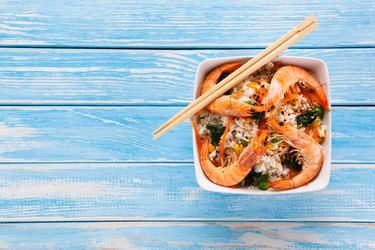
Boiling raw shrimp is one of the healthiest ways to prepare it. According to the U.S. Department of Agriculture FoodData Central, a 3-ounce serving of raw shrimp contains 72 calories and 17 grams of protein. Boiling doesn't add additional calories or fat compared to frying.
As one of the safest seafood options, the U.S. National Library of Medicine says shrimp accounts for about half of the seafood Americans eat. It's a highly versatile option because you can make spicy boiled shrimp, eat it with cocktail sauce, make it as part of a pasta dish, fry it or bake it.
Video of the Day
Video of the Day
Shopping for Shrimp
Raw shrimp is available as fresh or frozen, tail on or tail off and peeled and deveined. You may even be able to find it with the heads still on at specialty seafood markets.
As you consider what to buy, look at the count rather than size. According to Purdue University, shrimp are sold by the number of shrimp in a pound. If the label says 21/25, that means you get 21 to 25 shrimp per pound. If you see something that says "U/15" that means you'll get under 15 shrimp per pound.
Does the shrimp species you use matter? A July 2016 study published in Cogent Food & Agriculture showed the nutritional composition of the pink shrimp and the tiger shrimp was statistically insignificant.
Isn't shrimp high in cholesterol? Doesn't that make it bad for you? An October 2015 study published in Nutrition Research and Practice revealed consuming fish and shellfish regularly significantly reduced blood pressure and triglycerides levels compared to people who did not make shellfish part of their regular diets.
Read more: 4 Types of Food a Pescatarian Can Eat
Clean and Prepare Raw Shrimp
If you purchased raw shrimp that hasn't yet been peeled and deveined, you may want to take time to clean them.
The Culinary Institute of America says to grab the shrimp from the middle of the inside curve and pull it to remove the shell. You can also remove the tail, or leave it on, depending on your preference. To remove the tail, pinch and pull the back of it.
On the outside curve, you'll see the digestive tract. Though removing it isn't necessarily going to change the flavor or cause harm, you can remove it quickly and easily in a process known as deveining.
Score the back of the shrimp with a paring knife. Open the skin. Use the tip of the knife to pull the dark vein out. Rinse the shrimp in a small bowl of water. Repeat until all raw shrimp are clean.
If you want to get straight to making your spicy boiled shrimp, you can also leave the shells on and peel before you eat them. Keep in mind, however, boiled shrimp with Old Bay won't have a lot of the flavor in the shrimp itself if seasoned with the shell still on.
Read more: What Is the Nutritional Value of Shrimp?
Boiling Raw Shrimp
After all the shrimp are peeled and deveined, bring a large pot of water to a boil. Add a teaspoon of salt. If you wish, you can also make spicy boiled shrimp by adding your choice of seasonings to the water before cooking begins. If you don't want heat, boiled shrimp with Old Bay is a tasty alternative.
Once the water is boiling, drop the shrimp into the pot. Reduce the heat to a simmer. Cooking time depends on the size of the shrimp. Clemson University's College of Agriculture, Forestry and Life Sciences says it takes 3 to 5 minutes to boil 1 pound of medium shrimp with the shell on. Watch for them to turn to a bright pink and become opaque. When this happens, remove them from heat, drain and serve.
You can also season boiled shrimp with Old Bay after cooking, for a bit of extra flavor. Or, spritz it with lemon juice for some acidic flavor.
If you have frozen shrimp, there's no need to thaw before boiling raw shrimp. Bring your water to a boil. Run the frozen shrimp under cold water to remove debris. Dry the shrimp with a paper towel. Add to the boiling water then simmer until cooked through.
- U.S. Department of Agriculture FoodData Central: "Crustaceans, Shrimp, Raw"
- U.S. National Library of Medicine: "A Framework for Assessing Effects of the Food System"
- Congent Food & Agriculture: "Comparative Study on the Nutritional Composition of the Pink Shrimp and Tiger Shrimp from Lagos Lagoon, Southwest Nigeria"
- Nutrition Research and Practice: "Association Between Fish and Shellfish, and Omega-3 PUFAs Intake and CVD Risk Factors in Middle-Aged Female Patients With Type 2 Diabetes"
- Culinary Insitute of America: "How To: Work With Fresh Shrimp"
- Clemson University College of Agriculture, Forestry and Life Sciences: "Safe Handling of Seafood"
- Purdue University: "Profitability of Indoor Production of Pacific White Shrimp"
- FoodSafety.gov: Seafood
- What's Cooking America: All About Shrimp